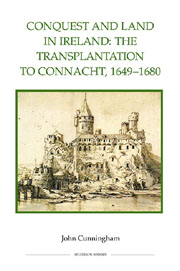Book contents
- Frontmatter
- Contents
- List of maps
- Acknowledgements
- Abbreviations
- Introduction
- 1 Conquest and land in Cromwellian Ireland, 1649–1652
- 2 Towards plantation and transportation, 1652–1654
- 3 The land settlement under threat, 1653–1655
- 4 Enforcing transplantation, 1655–1659
- 5 Transplantation in County Roscommon
- 6 The transplanters and the Restoration land settlement
- Conclusion
- Bibliography
- Index
1 - Conquest and land in Cromwellian Ireland, 1649–1652
Published online by Cambridge University Press: 05 February 2013
- Frontmatter
- Contents
- List of maps
- Acknowledgements
- Abbreviations
- Introduction
- 1 Conquest and land in Cromwellian Ireland, 1649–1652
- 2 Towards plantation and transportation, 1652–1654
- 3 The land settlement under threat, 1653–1655
- 4 Enforcing transplantation, 1655–1659
- 5 Transplantation in County Roscommon
- 6 The transplanters and the Restoration land settlement
- Conclusion
- Bibliography
- Index
Summary
The Cromwellian conquest of Ireland is synonymous with massacre, death and destruction. Inevitably therefore, its more controversial incidents, particularly the mass killing at Drogheda, have been frequently explored by historians. Although the military events which unfolded at Drogheda, Wexford, Scarrifhollis, Limerick and elsewhere were of undoubted importance in shaping the course of the conquest, in this chapter they will necessarily be consigned to the background. Such an approach is adopted not so as to minimise the monumental violence and human suffering which occurred, but because it can enable the shedding of fresh light on other relatively neglected aspects of the history of the conquest. The main focus here will be on the policies proposed and employed by the English leadership in Ireland to foster settled conditions while the protracted military struggle still raged. Alongside their quest for victory in siege and battle, Oliver Cromwell, Henry Ireton and the commissioners of parliament sought both to secure the co-operation of the existing civilian population and to commence the introduction of Protestant colonists as soon as possible. Although the efforts of Cromwell and his immediate successors in these two areas rarely produced the desired results, their policies did gradually evolve into more concrete plans for a lasting settlement. It is essential therefore to examine carefully these wartime measures, because they helped to prepare the way for the schemes of plantation and transplantation which were eventually approved at Westminster.
- Type
- Chapter
- Information
- Conquest and Land in IrelandThe Transplantation to Connacht, 1649-1680, pp. 11 - 30Publisher: Boydell & BrewerPrint publication year: 2011

